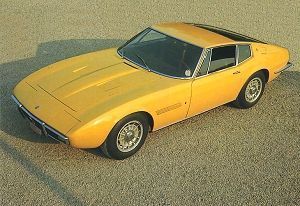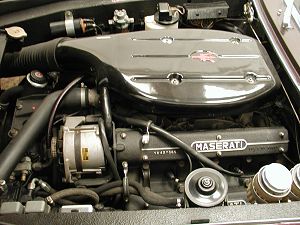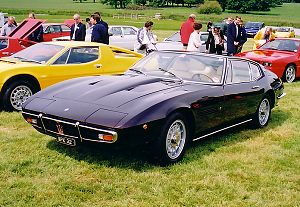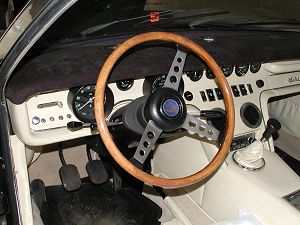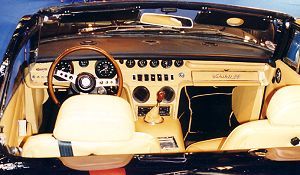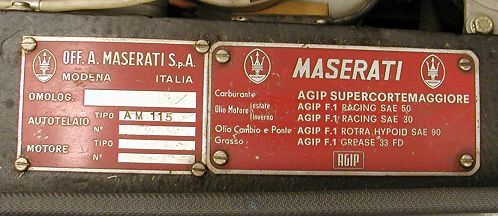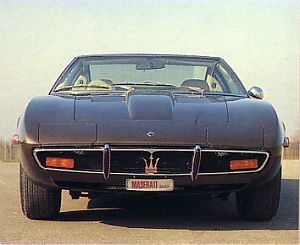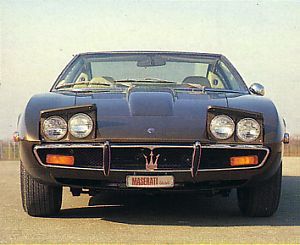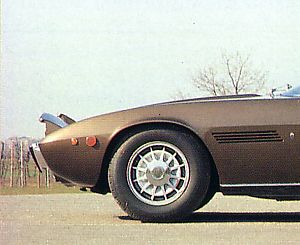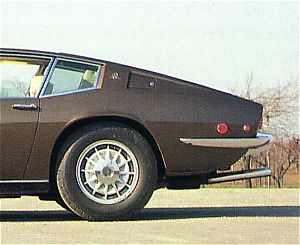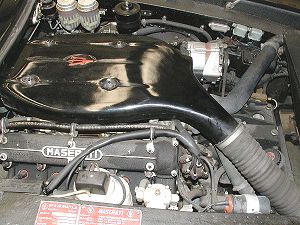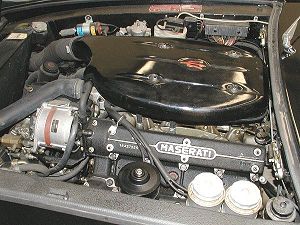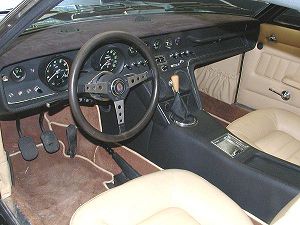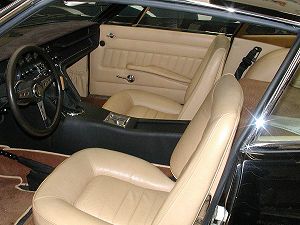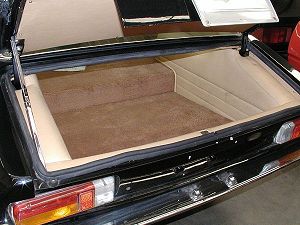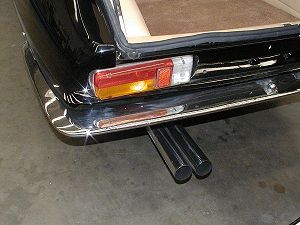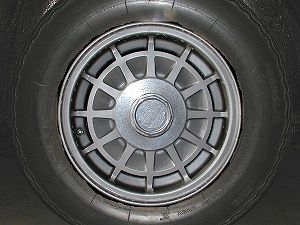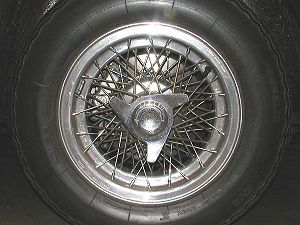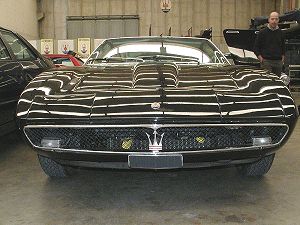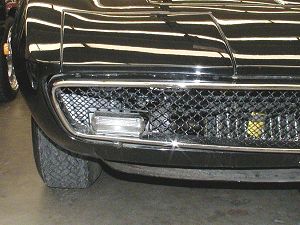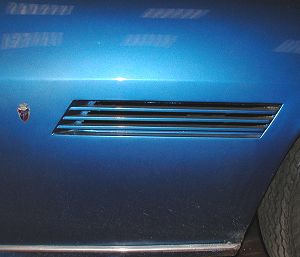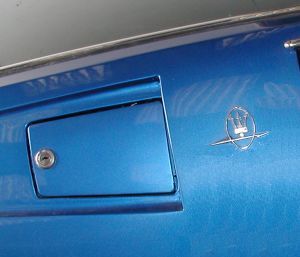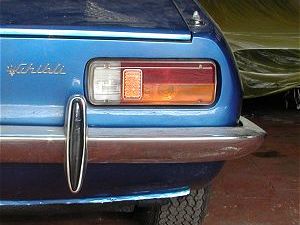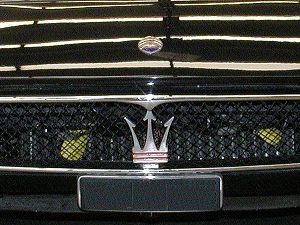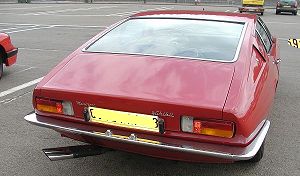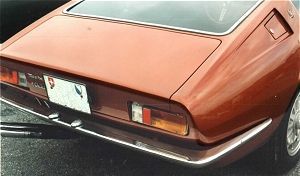| The Ghibli
"Ghibli... a hot dust bearing wind of the North African desert." |
 |
||
"Ghibli, il vento caldo del deserto che rende tutto più insopportabile e che copre ogni cosa con un tappeto di sabbia." excerpt from the book Ghibli by | :
|||
"Ghibli, a hot desert wind that renders all things more unbearable and covers everything with a carpet of sand." | |||
|
|
|||
|
In 1966, Maserati launched the Ghibli at the Salone di Torino initially to complement, but eventually to replace, the Mistral, but above all to satisfy the demands of its customers who now demanded an even faster and more powerful car. |
|||
|
During testing for Le Mans, one of the 151s - #002 to be precise - achieved a staggering 308 kph along the Mulsanne straight! |
|||
The chassis was a shortened version of that used in the 3500GT and the 'Mexico' with extra struts introduced to provide a more rigid frame. Front suspension was independent with double wishbones, coil springs, hydraulic shock absorbers and an anti-roll bar and rear suspension was by a Salisbury live axle with semi-elliptical leaf springs, hydraulic shock absorbers and anti-roll bar. The overall package, although now somewhat dated, gave the car excellent handling capability. |
|||
 |
 |
||
Carrozzeria Ghia, now owned by Alejandro De Tomaso, knew only too well what was required ot the Casa del Tridente: a Gran Turismo that was well equipped, spacious, comfortable and above all fast. The result was a very low (only 116 cm in height compared with the 120 cm of its competitors) and particularly slender design. Giugiaro's splendid design disguised a kerb weight of around 3500 lbs but could not hide an overall length of some 18ft. It would have been a great pity if it had! |
|||
The ample interior offered two comfortable front seats, behind which were two emergency seats. However, this coupé was primarily a two-seater with the rear area of approximately 0.6 cubic metres, in reality designed as luggage space accessed via a small rear boot lid. The dashboard housed a comprehensive array of instruments and controls, all within easy reach of the driver. |
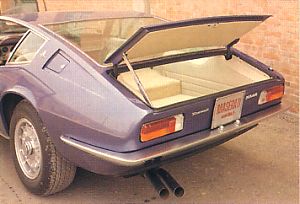 |
||
The body of the Ghibli was considered the best ever constructed by Maserati, not plagued by some of the smaller and sometimes bigger problems that are unavoidable in low series production. The Ghibli's paintwork and finish were always impeccable. |
|||
When first shown at the Salone di Torino in 1966, the Ghibli was offered in Coupé version at ITL 7.800.000 and in the Spyder version at IT L8.000.000. It was equipped with many extras normally associated with the more luxurious end of the market: air conditioning, power steering, electric windows, ventilated disc brakes and dual fuel tanks giving a fuel capacity of 100 litres. Its success was immediate, especially in the North American market: between 1967 and 1973, 1274 cars of which 125 were spyders were built. In its Spyder form, produced from 1968, the Ghibli looked more beautiful, even when fitted with the optional hard-top. |
|||
Alas in 1973 the era of the Ghibli came to a close: another splendid model replaced it, but without a doubt, this car with its combination of outstanding performance, beautiful design, immaculate finish and build quality has left a lasting impression on the history of Maserati and the Italian Gran Turismo. |
|||
| TECHNICAL DATA - TIPO AM.115 | |
| Body type | 2+2 Coupé |
| Production years | From 1966 to 1973 |
| Engine | Front engined V8-cylinder @ 90º |
| Bore and stroke | 93.9 mm X 85 mm (from 1970 93.9 x 89 mm) |
| Engine capacity | 4719 cc (from 1970 4930 cc) |
| Compression ratio | 8.5:1 |
| Maximum power | 330 bhp @ 5000 rpm (from 1970 335 bhp @ 5500 rpm) |
| Distribution | Four overhead camshafts, two valves per cylinder |
| Induction system | Four twin-choke 40 DCNL/5 Weber carburettors |
| Ignition | Single with Marelli distributor |
| Lubrification | Forced with pressure pump |
| Transmission | Rear wheel drive |
| Differential | Salisbury 'live' axle |
| Clutch | Dry single plate with flexible coupling and hydraulic control |
| Gearbox | 5 speed and reverse |
| Chassis | Welded tubular chassis |
| Front suspension:- | Independent wheels, coil-springs, telescopic shock-absorbers and anti-roll bar |
| Rear suspension:- | Rigid axle, semi-elliptical leaf-springs, telescopic shock-absorbers and anti-roll bar |
| Brakes | Hydraulically operated disc brakes on all four wheels |
| Wheelbase | 2550 mm |
| Wheel tracks | Front 1440 mm Rear 1400 mm |
| Tyres | Front:- 205 x 15 (215 x 15) Rear:- 205 x 16 (215 x 15) |
| Dry weight | 1200 kg |
| Maximum speed | 270 kph (from 1970 280 kph) |
| Models constructed | 1274 including 125 Spyders |
 |
|
To enter Enrico's Maserati Pages CLICK HERE! Copyright: Enrico's Maserati Pages - © 2002-2004. All rights reserved. |
